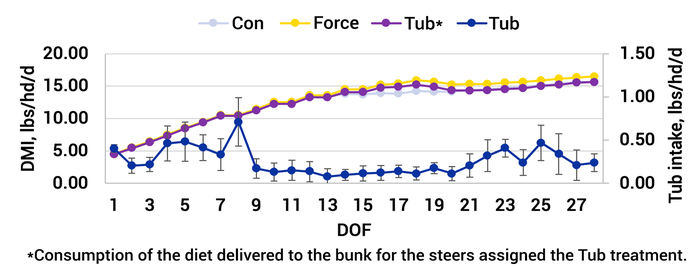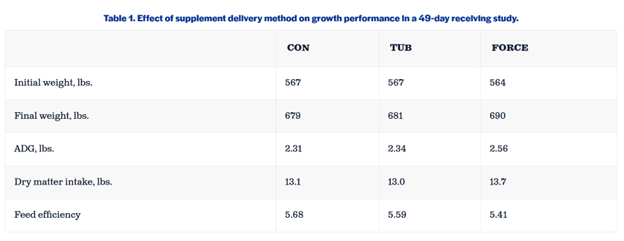Supplement delivery methods for weaned calves
Posted on August 21, 2024
Source: Farm Progress. The original article is posted here.

By Warren Rusche, SDSU Extension
Successfully transitioning calves from nursing through weaning into the next phase of beef production can be stressful, for both cattle and managers alike. Calves must adapt to new diets and environments and often face pathogen threats they did not face on their home ranch. Vaccination protocols, pre-weaning management, and strategies to reduce stress are all important management considerations for successful weaning. One of the most-critical success factors in this process is ensuring that calves consume sufficient nutrients to support their immune system and for setting them up for rapid, efficient gains throughout the feeding period.
Providing sufficient trace minerals and feed additives, such as Saccharomyces cerevisiae yeast culture products, are proven approaches that can affect the health of both the animal and the rumen environment. The research question we wanted to ask was how effective different methods were to deliver these nutrients; specifically, how did providing a self-fed, cooked molasses block compare to including these additives directly to the diet.
What we did
We used 192 crossbred steer calves in this experiment. These calves all came from a single ranch in western South Dakota, and based on prior experience with this set of cattle, we expected that they would have low concentrations of liver copper. These calves were weaned on the ranch and shipped to the research feedlot at SDSU in Brookings. The steers were vaccinated using our standard receiving protocol, and we also sampled a subset for liver trace mineral concentrations. We started the steers on a receiving diet of wheatlage, oat hay, dried distiller and soyhulls that contained 13% crude protein and 47 Mcal/cwt NEg. The steers were then divided into three groups.
Steer groups
The three steer groups in the experiment included:
Receiving diet supplemented with inorganic trace minerals at concentrations to meet the nutrient requirements for growing beef steers ( CON ).
Receiving diet plus a low-moisture, cooked molasses tub containing organic trace minerals and a yeast culture product placed in the pen ( TUB ).
Receiving diet plus a supplement mixed in the diet containing organic trace minerals and a yeast culture product ( FORCE ). The supplement was designed to match the TUB treatment if the steers ate 0.5 pounds per day of the tub.
The TUB and FORCE treatments were fed for the first 28 days of the study. We weighed the tubs daily to estimate tub intake. We conducted liver biopsies on day 14, 28, and 49 to compare against the baseline samples. The entire study lasted for 49 days.
What we found
Feed Intake
Tub disappearance and dry matter intake for the first 28 days are shown in Figure 1 (blue “Tub” line). Based on the Tub label, the steers in this experiment should have consumed between 0.33 and 0.5 pounds per day. However, they only averaged 0.25 pounds per day for the first 28 days of the study. Tub consumption was greater than expected for the first nine days, but it decreased after that time. Calves on the FORCE treatment had greater feed intake than the CON or TUB treatments during the first 28 days and for the entire 49-day experiment.

Liver copper concentrations
We saw notable differences in liver concentrations of copper as shown in Figure 2. All groups started at near-zero concentrations of copper in the liver, and all groups increased over the course of the experiment. Steers on the FORCE treatment had greater liver copper concentrations compared to every other group throughout the study. Steers on the TUB treatment had greater liver copper concentrations than the CON treatment at day 14 and day 28, and their liver copper concentrations would be considered sufficient by day 14.

Growth performance
Differences in growth performance are shown in Table 1. Overall differences were small, but steers fed FORCE ate more and gained faster, with no differences in feed efficiency. There were no differences in health outcomes in this study.

What does this mean?
Both the tubs and force-fed supplement were effective at rebuilding liver copper stores. FORCE also increased cobalt concentrations, but there were no differences for manganese or zinc. In this study, steers dramatically reduced intake after about nine days. This is similar to an earlier study we conducted at SDSU with calves from the same ranch where tub consumption decreased after five days. Including both trace minerals and a yeast product in the diet for 28 days resulted in eleven pounds more gain over the seven-week study period.
Supplement approach
So, which approach is the best? The answer depends on what resources you have available and the kind of cattle that you are feeding. The FORCE treatment resulted in the most-rapid rebuilding of copper stores and supported the highest gains. In order to achieve that outcome, the FORCE treatment was fed for 28 days compared to fewer days of actual tub consumption. We do not know if the supplement needs to be fed for a full 28 days or if we could shorten the feeding period to perhaps 14 days and achieve comparable results.
In our studies, calves reduced their intake of the tubs after about 7 to 10 days. That might be long enough, considering that liver copper concentrations were adequate by that point. The tubs are more convenient, but convenience comes at a greater cost per unit of feed or nutrient. In some cases, the cost may be justified if it saves labor, simplifies diet mixing and manufacturing needs, or reduces the amount of product on inventory.
Health response
What about health responses? It may be tempting to look at the “bare bones” treatment and compare that to the same performance with zero health issues and conclude that additional supplementation is not necessary. However, before one reaches that conclusion, keep in mind that this scenario does not represent normal calf receiving conditions. First, these steers were not co-mingled, which reduces the risk of disease. Secondly, because we need replicated pens to determine what effects these diets may cause; this experiment was conducted with eight steers per pen. It is much easier to locate sick animals in those conditions, and calves have less competition at the bunk. The bare bones approach in a group of calves from multiple sources fed in one group could easily result in a very different outcome in terms of sickness and death loss.

.jpg?disable=upscale&width=1200&height=630&fit=crop)


